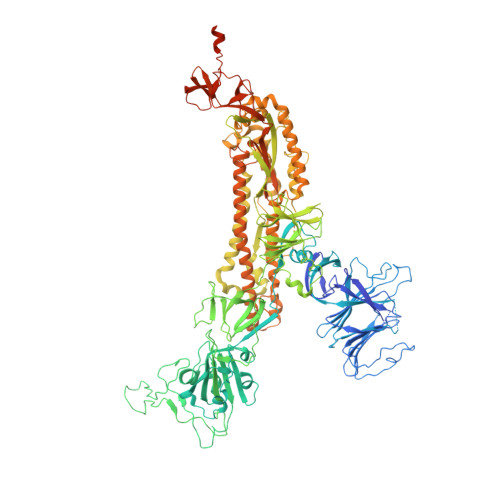Convergence of immune escape strategies highlights plasticity of SARS-CoV-2 spike.
Yu, X., Juraszek, J., Rutten, L., Bakkers, M.J.G., Blokland, S., Melchers, J.M., van den Broek, N.J.F., Verwilligen, A.Y.W., Abeywickrema, P., Vingerhoets, J., Neefs, J.M., Bakhash, S.A.M., Roychoudhury, P., Greninger, A., Sharma, S., Langedijk, J.P.M.(2023) PLoS Pathog 19: e1011308-e1011308
- PubMed: 37126534
- DOI: https://doi.org/10.1371/journal.ppat.1011308
- Primary Citation of Related Structures:
8FU7, 8FU8, 8FU9 - PubMed Abstract:
The global spread of the SARS-CoV-2 virus has resulted in emergence of lineages which impact the effectiveness of immunotherapies and vaccines that are based on the early Wuhan isolate. All currently approved vaccines employ the spike protein S, as it is the target for neutralizing antibodies. Here we describe two SARS-CoV-2 isolates with unusually large deletions in the N-terminal domain (NTD) of the spike. Cryo-EM structural analysis shows that the deletions result in complete reshaping of the NTD supersite, an antigenically important region of the NTD. For both spike variants the remodeling of the NTD negatively affects binding of all tested NTD-specific antibodies in and outside of the NTD supersite. For one of the variants, we observed a P9L mediated shift of the signal peptide cleavage site resulting in the loss of a disulfide-bridge; a unique escape mechanism with high antigenic impact. Although the observed deletions and disulfide mutations are rare, similar modifications have become independently established in several other lineages, indicating a possibility to become more dominant in the future. The observed plasticity of the NTD foreshadows its broad potential for immune escape with the continued spread of SARS-CoV-2.
Organizational Affiliation:
Structural & Protein Sciences, Janssen Research and Development, Spring House, Pennsylvania, United States of America.















